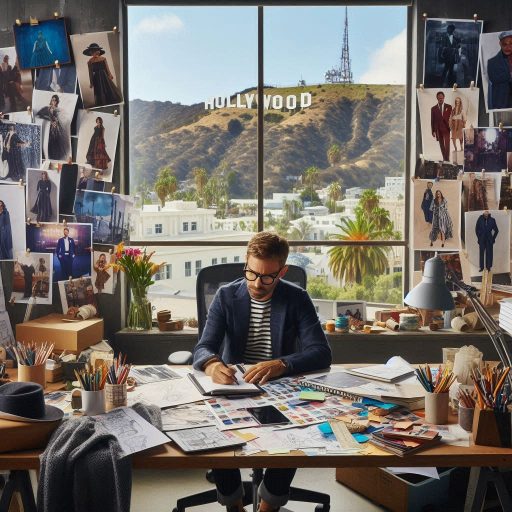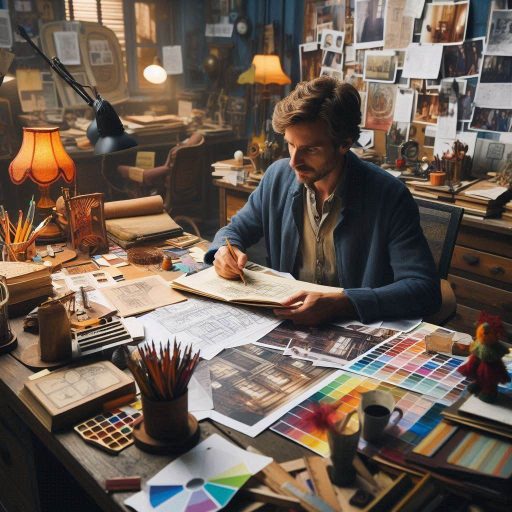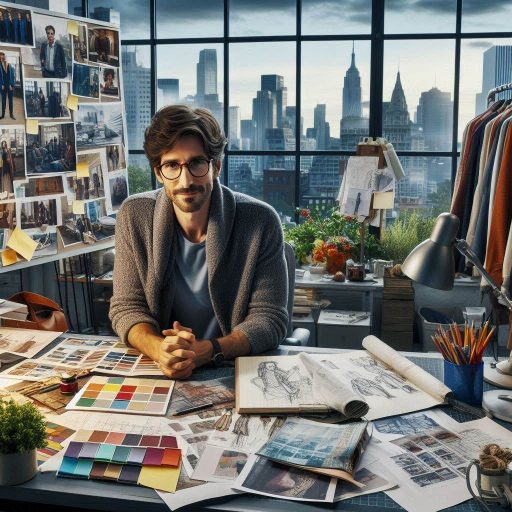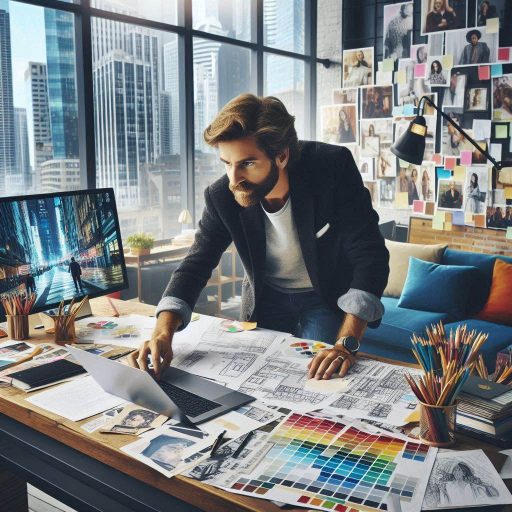Introduction
Production design is essential in film and television, as it shapes the visual storytelling.
It establishes the atmosphere and mood, engaging audiences and enhancing their experience.
Without effective production design, stories can lose their emotional impact and depth.
Production design encompasses various visual elements, including set design, props, colors, and textures.
Each aspect contributes to the overall aesthetic and helps convey the story‘s themes.
A well-designed environment immerses viewers in the narrative, making the fictional world feel authentic and relatable.
Production designers play a key role in bringing scripts to life on screen.
They interpret the screenplay, collaborating with directors to develop a cohesive visual style.
This process involves creating detailed sketches and models to visualize the proposed designs.
Throughout production, designers oversee set construction and decoration, ensuring everything aligns with the creative vision.
They also work closely with other departments, such as cinematography and costumes, to maintain visual consistency.
Production design is crucial in film and television.
It encompasses various visual elements that enhance storytelling and create immersive experiences.
Production designers are instrumental in transforming scripts into compelling visual narratives, making their role vital in the industry.
The Script
How the Script Serves as the Foundation for the Production Design
The script acts as the foundation for all aspects of film production, including production design.
It provides the story‘s framework, characters, and setting details.
Production designers rely on the script to develop a cohesive visual narrative.
Each scene’s descriptions help designers understand the intended atmosphere and mood.
By analyzing the script, they can identify key elements that require visual representation.
This process allows designers to create environments that reflect the story’s themes and tone.
Moreover, the script outlines the characters’ journeys, influencing design choices.
Designers consider how each character interacts with their environment.
This understanding shapes the design to enhance the storytelling experience.
Ultimately, the script serves as a blueprint.
It guides production designers in crafting immersive worlds that resonate with audiences.
A strong connection between the script and production design enriches the film’s overall impact.
How Production Designers Analyze the Script to Determine the Visual Requirements
Production designers begin by reading the script multiple times to understand its nuances.
They take detailed notes on scenes, settings, and character descriptions.
This analysis helps them identify visual requirements for each moment.
Designers create a list of key locations and elements essential for the narrative.
They consider how these settings influence the characters’ actions and emotions.
This process ensures that every design choice aligns with the story’s progression.
Collaboration with directors and cinematographers is vital during this phase.
Designers discuss their interpretations of the script and how to visualize them.
This teamwork fosters a shared vision that enhances the film’s overall aesthetics.
Additionally, production designers research relevant historical or cultural contexts.
This research informs their design choices, ensuring authenticity.
Designers may gather reference materials, such as photographs or artwork, to inspire their concepts.
By understanding the script‘s visual requirements, production designers can create environments that support the narrative.
This thoughtful analysis enhances the storytelling experience and captivates audiences.
Example of How Specific Details in the Script Can Influence the Production Design Process
Specific details in the script significantly influence the production design process.
For example, consider a scene set in a bustling caf‘.
The script might describe the caf‘’s warm, inviting atmosphere with vibrant colors and eclectic furniture.
This detail guides the production designer to choose a color palette that reflects this ambiance.
They may select warm tones like oranges and yellows to evoke a sense of comfort.
Additionally, they will design the layout to accommodate the expected crowd, ensuring it feels lively and inviting.
Another example occurs in a thriller script that calls for a dark, foreboding basement.
The script might detail flickering lights and damp walls, creating an unsettling atmosphere.
This information prompts the production designer to utilize shadows and stark contrasts to enhance tension.
They might incorporate low-hanging bulbs and industrial materials to achieve the desired effect.
This design choice contributes to the film’s overall mood and supports the narrative‘s tension.
Furthermore, character details can also influence production design.
If a character is an artist living in a chaotic studio, the script may describe scattered art supplies and vibrant paintings.
This detail encourages the designer to create an environment that reflects the character’s personality and passions.
The script is vital in shaping production design.
It provides the foundation upon which designers build immersive worlds.
By analyzing the script, production designers can determine the visual requirements essential for storytelling.
Specific details in the script guide design choices, enhancing the narrative and engaging audiences.
A strong collaboration between the script and production design elevates the overall cinematic experience.
Read: Character Design Trends: What‘s Hot in 2024?
Conceptualization
How Production Designers Collaborate with the Director and Other Key Creatives
Production designers play a crucial role in transforming scripts into visual narratives.
They collaborate closely with the director and other key creatives.
This collaboration begins early in the pre-production phase.
The production designer meets with the director to discuss their vision and themes.
They explore how the visual elements can enhance storytelling.
During initial meetings, they analyze the script together.
The production designer identifies locations, settings, and character environments that support the narrative.
This collaboration ensures a cohesive vision throughout the filmmaking process.
The designer also engages with the cinematographer and costume designer.
This teamwork helps integrate visual elements across various departments.
Regular communication is essential during the conceptualization phase.
Production designers share ideas and receive feedback from the director and team.
They often adjust designs based on collaborative discussions.
This iterative process allows for a rich exchange of ideas.
The end goal is to create a unified visual concept that aligns with the director‘s vision.
Description of the Mood Boards, Sketches, and Other Tools Used During the Conceptualization Phase
Production designers utilize various tools to develop their visual concepts.
One essential tool is the mood board.
Mood boards compile images, colors, textures, and materials that convey the desired aesthetic.
They serve as a visual reference for the entire production team.
Sketches are another vital tool in the conceptualization phase.
Production designers create detailed drawings of sets, props, and environments.
These sketches help visualize how the space will look and feel.
Designers often use digital software to create 3D models and renderings.
These tools allow for more accurate representations of the final designs.
Additionally, designers may use reference images from art, architecture, and film.
These references inspire their creative process and help establish a cohesive visual language.
They often include historical and cultural influences in their designs to enhance authenticity.
Collaboration tools, such as digital platforms, help facilitate communication among team members.
Designers share mood boards and sketches through these platforms for feedback and revisions.
This streamlined process ensures everyone is on the same page and allows for real-time adjustments.
Example of How a Strong Visual Concept Can Enhance the Overall Storytelling of a Film or TV Show
A strong visual concept significantly enhances storytelling in film and television.
For example, in “Blade Runner 2049,” production designer Dennis Gassner created a dystopian world.
The meticulously crafted environments reflect themes of isolation and humanity‘s relationship with technology.
The visual design immerses viewers in a haunting yet beautiful future.
In “The Grand Budapest Hotel,” Wes Anderson‘s distinct visual style supports the film’s whimsical narrative.
The vibrant colors and symmetrical compositions create a fairy tale-like atmosphere.
This design approach amplifies the film‘s emotional depth and charm.
Another example is the TV series “Stranger Things.
” Production designer Gregor Tavenner developed a nostalgic 1980s setting.
The attention to detail in the design evokes feelings of nostalgia and enhances the storyline.
The visual elements align seamlessly with the plot, making the world feel authentic and relatable.
In each of these examples, strong visual concepts elevate the storytelling.
The collaboration between production designers, directors, and key creatives ensures that the visuals resonate with the audience.
By merging aesthetics with narrative, they create immersive experiences that leave lasting impressions.
Production design plays a vital role in the transition from script to screen.
Collaboration between production designers and directors shapes the visual concept.
Tools like mood boards and sketches facilitate the conceptualization process.
Ultimately, a strong visual concept enhances storytelling, creating memorable cinematic experiences.
Read: How to Price Your Ceramic Artwork
Location Scouting
Importance of Finding Suitable Locations
Finding suitable locations is crucial in the production design process.
Locations must align with the overall vision of the film.
The right setting enhances the story and immerses the audience in the narrative.
A well-chosen location can evoke specific emotions.
For example, a dark forest can create suspense, while a vibrant city can inspire excitement.
The environment sets the tone and reinforces the film‘s themes.
Production designers consider various factors when selecting locations.
They evaluate how the space complements the characters and plot.
Every element in the location should support the storytelling.
Additionally, the location must reflect the time period of the film.
Historical accuracy adds authenticity to the production design.
Designers conduct thorough research to ensure the chosen locations fit the narrative.
Moreover, finding suitable locations helps maintain visual consistency.
Each setting should seamlessly blend with other environments in the film.
This cohesion enhances the overall aesthetic and strengthens the audience’s connection to the story.
How Production Designers Work with Location Scouts
Production designers collaborate closely with location scouts during the scouting process.
Location scouts are responsible for finding potential filming sites that match the creative vision.
They have extensive knowledge of available locations and can recommend suitable options.
Initially, production designers share their vision with location scouts.
They discuss the desired mood, style, and practical requirements for each location.
This collaboration ensures that scouts understand the specific needs of the production.
Location scouts conduct thorough research to identify potential sites.
They explore various neighborhoods, landscapes, and architectural styles.
This exploration allows them to present a diverse range of options to the production team.
Once potential locations are identified, production designers visit these sites.
They assess how well each location aligns with the overall design vision.
This evaluation helps determine which sites best fit the film’s narrative.
Additionally, location scouts provide valuable insights into logistics.
They consider factors like accessibility, permits, and local regulations.
Their expertise helps streamline the planning process, ensuring a smoother production experience.
Impact of Location Scouting on Budget and Overall Look
Location scouting significantly impacts the production budget.
Some locations may require extensive modifications to fit the design vision.
These changes can increase costs, so careful planning is essential.
Travel expenses for location scouting can also add to the budget.
Scouts may need to visit multiple sites before making a decision.
Each trip incurs costs that production teams must account for in their budgets.
However, finding the right location can ultimately save money.
A well-chosen site may require minimal alterations, reducing overall production costs.
Additionally, choosing a location that fits the story can prevent costly reshoots or adjustments later.
Moreover, the overall look of a production is influenced by the selected locations.
A visually stunning site can elevate the film’s aesthetic.
This enhancement can make a significant difference in audience engagement and critical reception.
Location scouting impacts not only the visual appeal but also the storytelling.
The chosen settings shape the characters’ journeys and emotional arcs.
Effective location scouting can enhance the narrative and create memorable cinematic moments.
The process of finding suitable locations plays a vital role in production design.
Collaboration between production designers and location scouts ensures that the vision comes to life.
Location scouting impacts both the budget and the overall look of a production.
By carefully selecting locations, filmmakers can create immersive environments that captivate audiences and enhance storytelling.
This thoughtful approach to production design ultimately contributes to a successful film.
Read: Top Skills Needed for a Successful Character Designer
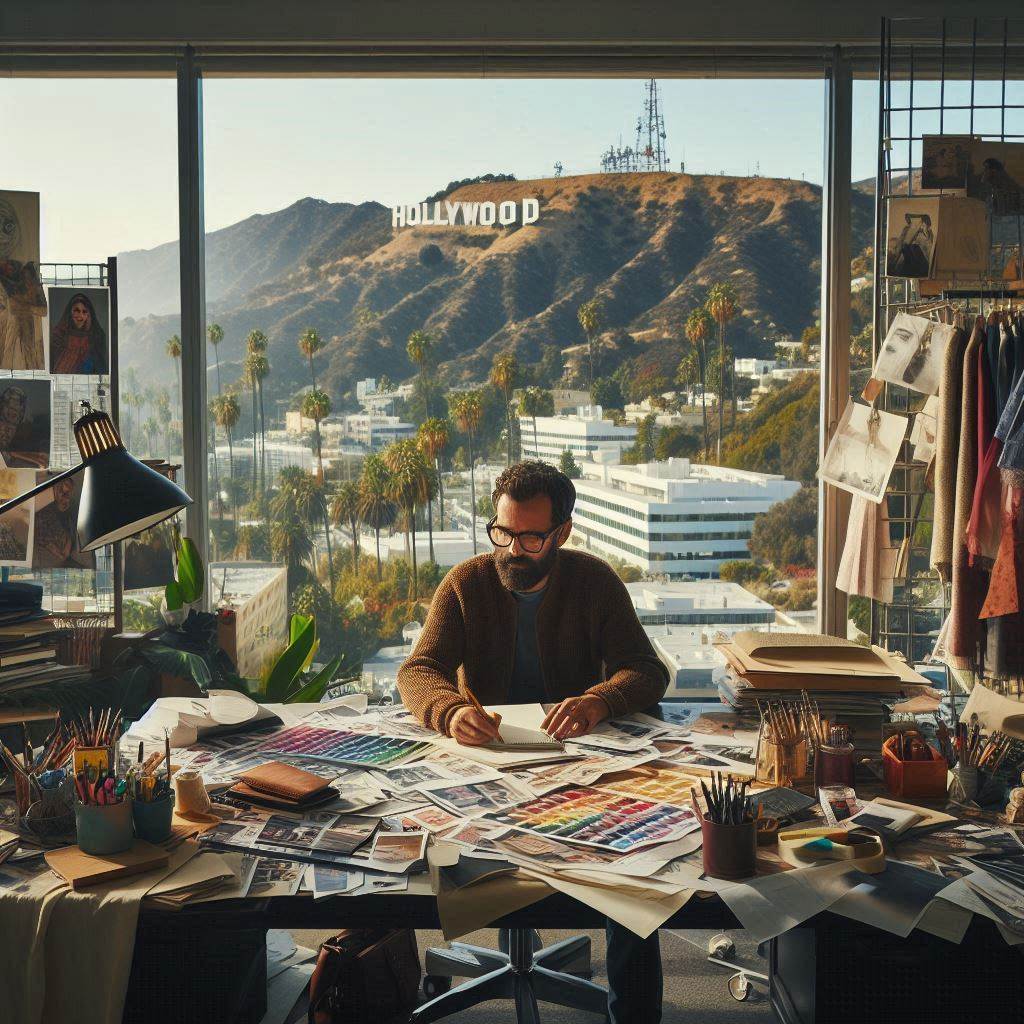
Set Design
Overview of the Set Design Process
The process of designing and constructing sets for film and television begins with a thorough understanding of the script.
Production designers analyze the script to identify key settings and visual themes.
They consider the story‘s tone, genre, and character motivations.
This analysis informs their creative vision and design choices.
Next, production designers create concept art and sketches.
These visual representations help communicate their ideas to directors and producers.
Designers often develop mood boards to capture the overall aesthetic and color palette.
These tools guide the design process and ensure alignment with the project’s vision.
Once the concept is approved, designers develop detailed plans.
They create blueprints and scale models to visualize the set’s layout.
This planning phase involves considering practical aspects, such as space, lighting, and camera angles.
Designers also determine materials and textures to enhance the set’s authenticity.
Construction begins once the design is finalized.
The design team collaborates closely with carpenters and other crew members.
They work together to build the set according to the specifications.
This collaboration ensures that every detail aligns with the production designer’s vision.
Throughout construction, production designers conduct regular walkthroughs.
These visits allow them to monitor progress and address any issues.
They ensure that the set captures the intended atmosphere and aesthetics.
Once completed, the set undergoes final adjustments and detailing.
Collaboration with the Crew
Collaboration is essential for successful set design.
Production designers work closely with set decorators to add finishing touches to the sets.
Set decorators select and arrange furniture, props, and decor that enhance the overall look.
Effective communication between production designers and set decorators ensures a cohesive visual style.
Both teams must share a unified vision for the project.
This collaboration helps create environments that feel authentic and believable.
Additionally, production designers collaborate with other crew members, such as lighting technicians.
These technicians ensure that lighting complements the set design.
Coordinating with the cinematographer is also vital for achieving the desired visual effects.
They work together to determine camera placements that highlight the set’s features.
Moreover, collaboration extends to the art department, including painters and sculptors.
These artists help bring the set to life by adding textures and colors.
The entire crew contributes to creating immersive environments that support the story.
Example of Memorable Set Design
One memorable example of set design is the vibrant world of “The Grand Budapest Hotel.
” Production designer Adam Stockhausen collaborated closely with director Wes Anderson to create this whimsical environment.
The film’s aesthetic draws heavily from a combination of pastel colors and elaborate architectural styles.
The hotel set, with its pink facade and ornate interiors, instantly captures the viewer’s attention.
Each room is meticulously designed, reflecting the quirky personality of the film.
The attention to detail in the props and furnishings enhances the story’s charm.
Stockhausen’s collaboration with set decorators and artisans brought the hotel to life.
They carefully curated every element, from the lobby’s chandeliers to the guest rooms’ bedding.
This collaboration created a cohesive visual experience that supports the film’s narrative.
The success of “The Grand Budapest Hotel” showcases the power of production design.
The set not only serves as a backdrop but also enhances the storytelling.
Viewers are transported to a unique world that feels both fantastical and authentic.
The journey from script to screen involves a detailed process of set design and construction.
Production designers play a vital role in shaping the visual narrative.
Collaboration with set decorators, carpenters, and crew members ensures that every detail aligns with the project’s vision.
Memorable set designs, like those in “The Grand Budapest Hotel,” demonstrate the impact of effective production design on storytelling.
By prioritizing collaboration and creativity, filmmakers can craft immersive worlds that resonate with audiences.
Read: Career Paths in Ceramic Art and Design
Props and Costumes
How Props and Costumes Contribute to the Overall Production Design
Props and costumes are vital components of production design.
They enhance storytelling by visually representing characters, settings, and themes.
These elements help create a believable world that immerses the audience in the narrative.
Props serve practical functions while also conveying deeper meanings.
For example, a character’s weapon can symbolize power or danger.
Similarly, a personal item can reveal aspects of a character’s background.
Through careful selection, props add layers of meaning to the story.
Costumes also play a crucial role in character development.
They reflect personalities, social status, and time periods.
A well-designed costume can instantly communicate a character‘s traits and motivations.
The audience understands who a character is based on their attire.
Together, props and costumes create a cohesive visual language that supports the film‘s themes.
They work in harmony with sets and lighting to establish mood and atmosphere.
This synergy contributes to the overall effectiveness of the production design.
How Production Designers Select or Create Props and Costumes That Fit the Visual Style of the Project
Production designers play a critical role in selecting and creating props and costumes.
They collaborate with directors and costume designers to ensure alignment with the project‘s vision.
Understanding the story and its themes is crucial in this process.
Production designers often conduct extensive research to inform their choices.
They explore historical contexts, cultural influences, and stylistic trends relevant to the narrative.
This research helps them create authentic and visually appealing elements.
In some cases, production designers may need to create custom props or costumes.
They consider the characters‘ journeys and how these elements evolve throughout the story.
For example, a character’s costume might change to reflect personal growth or significant events.
When selecting props, production designers consider both aesthetics and functionality.
They strive for items that enhance the visual style while remaining practical for the actors.
This balance is essential for creating a seamless experience during filming.
Collaboration is key in this process.
Production designers regularly communicate with the costume and prop departments to ensure consistency.
They share ideas, sketches, and samples to align their visions and create a unified design.
Importance of Attention to Detail in Props and Costumes for Authenticity
Attention to detail is crucial for creating authentic props and costumes.
Small elements can significantly impact the audience’s perception of the story.
A carefully chosen accessory can evoke a specific time period or culture.
Production designers must pay close attention to color, texture, and materials.
These factors contribute to the overall believability of the film‘s world.
For instance, a costume made from authentic fabrics enhances realism and immerses viewers in the narrative.
Moreover, details in props can reveal character traits and backgrounds.
A cluttered desk can indicate a character‘s chaotic lifestyle, while a pristine one suggests orderliness.
Such nuances enhance the audience’s understanding of the characters‘ lives.
Authenticity also helps establish emotional connections between the audience and the characters.
When viewers believe in the world and its inhabitants, they become more engaged.
This connection heightens the impact of the story.
Props and costumes play a crucial role in production design.
They enhance storytelling by visually representing characters and themes.
Production designers carefully select or create these elements to fit the project‘s visual style.
Attention to detail ensures authenticity, enriching the audience‘s experience.
Through their contributions, props and costumes bring scripts to life, transforming words into compelling visual narratives.
Transform Your Career Today
Unlock a personalized career strategy that drives real results. Get tailored advice and a roadmap designed just for you.
Start NowColor Palette and Lighting
Importance of Choosing the Right Color Palette and Lighting to Enhance Visual Storytelling
Choosing the right color palette and lighting is essential in production design.
Colors evoke emotions and influence how audiences perceive a story.
For example, warm tones can create feelings of comfort and nostalgia.
In contrast, cooler tones may evoke sadness or detachment.
Lighting plays a crucial role in shaping the overall mood of a scene.
Bright, natural light often conveys happiness and clarity.
Dark, moody lighting can create tension and suspense.
Production designers must carefully consider these elements when designing sets and selecting colors.
The choice of color and lighting helps establish the film’s atmosphere.
These elements guide audience expectations and enhance character development.
A well-thought-out color palette and lighting scheme can transform a simple scene into an emotionally charged moment.
By emphasizing visual storytelling, production designers can captivate audiences and elevate the narrative.
How Production Designers Work with Cinematographers to Create a Cohesive Look
Production designers collaborate closely with cinematographers to achieve a cohesive visual style.
This partnership is crucial in ensuring that the film’s look aligns with its themes and tone.
They begin discussions early in the pre-production phase to establish a shared vision.
During this collaboration, production designers present their color palettes and set designs.
Cinematographers provide insights on how lighting and camera angles will interact with these elements.
Together, they determine how to create visual harmony between the sets and the cinematography.
This teamwork involves experimenting with different lighting techniques.
Cinematographers may test various setups to see how colors appear on screen.
Production designers adjust their choices based on these tests, ensuring that the overall look remains consistent.
In addition to color and lighting, they discuss texture and composition.
The production designer‘s choices influence how the cinematographer captures scenes.
This collaboration ultimately results in a unified visual language that enhances the storytelling.
Example of How Color and Lighting Choices Can Evoke Emotions or Set the Tone for a Scene
A powerful example of color and lighting choices influencing a scene can be found in “The Godfather”.
The film often uses warm, golden tones to create an intimate yet tense atmosphere.
This color palette reflects the characters‘ complex emotions and relationships.
In one iconic scene, the lighting casts deep shadows on the characters‘ faces.
This use of chiaroscuro emphasizes their moral dilemmas and the film‘s themes of power and loyalty.
The dramatic contrasts between light and dark create a sense of foreboding and tension, drawing viewers deeper into the narrative.
Another example is found in “La La Land”.
The vibrant colors and bright lighting during musical sequences evoke feelings of joy and hope.
The film contrasts these lively scenes with more subdued colors in dramatic moments.
This shift in color and lighting helps convey the characters’ emotional journeys and challenges.
In both films, the strategic use of color and lighting enhances the storytelling.
These choices evoke specific emotions and set the tone for each scene.
By working together, production designers and cinematographers create visually stunning moments that resonate with audiences.
The role of production design in visual storytelling is vital.
Choosing the right color palette and lighting enhances the film’s emotional impact.
Collaboration between production designers and cinematographers ensures a cohesive look that elevates the narrative.
Through careful consideration of color and lighting, filmmakers can create memorable cinematic experiences that engage and move audiences.
Continuity and Collaboration
The Importance of Maintaining Continuity in Production Design
Maintaining continuity in production design is essential for any film or television project.
Consistent design elements enhance the storytelling experience for the audience.
When visuals align with the narrative, they create a seamless viewing experience.
Continuity helps establish a cohesive world that audiences can believe in.
This consistency applies to colors, textures, and overall aesthetics.
Changes in design can distract viewers and disrupt their immersion in the story.
For instance, a character’s living space should reflect their personality and development.
If the design shifts unexpectedly, it can confuse the audience.
Thus, careful planning is crucial to ensure that every detail aligns with the character’s journey.
Moreover, continuity plays a vital role in time-sensitive projects.
Productions often shoot scenes out of sequence.
Maintaining consistent design elements across various takes is necessary to avoid discrepancies.
This attention to detail ensures a polished final product.
Effective continuity also extends to props and costumes.
These elements must align with the set design to create a unified look.
When all components work harmoniously, the story becomes more engaging and believable.
Collaboration with Various Departments
Production designers collaborate closely with several departments to maintain continuity.
Communication is key in ensuring that every team is aligned with the overall vision.
Collaboration starts early in the pre-production phase.
Working with the costume department is essential.
Designers need to understand the color palettes and styles of costumes.
This knowledge helps them create sets that complement the characters’ wardrobes.
Additionally, collaboration with the art department is crucial.
This team focuses on creating physical spaces that align with the production designer’s vision.
Frequent meetings ensure that everyone stays on the same page regarding design elements.
Sound and lighting departments also play significant roles in maintaining continuity.
Designers must consider how lighting affects the colors and textures of sets.
Coordination ensures that the final look matches the director‘s vision.
Moreover, visual effects teams contribute to continuity in the digital realm.
Designers must communicate how physical sets will interact with digital elements.
This collaboration ensures a seamless blend of practical and digital effects.
Regular check-ins and updates foster a collaborative atmosphere.
Production designers should encourage feedback from all departments.
This openness leads to innovative solutions and strengthens the final product.
Example of Effective Collaboration in Production Design
One notable example of effective collaboration elevating production design is Game of Thrones.
The production team faced the challenge of creating diverse worlds within the same series.
The collaboration between production designer Gemma Jackson and various departments was instrumental in achieving continuity.
Jackson worked closely with costume designers, prop masters, and location scouts.
This collaboration ensured that each setting was richly detailed and visually cohesive.
The production team meticulously planned each element to reflect the characters’ journeys and the story’s themes.
For instance, the stark differences between Winterfell and King’s Landing showcased the distinct cultures and atmospheres of each location.
The attention to detail in set design, costumes, and props contributed to the series’ immersive experience.
Each location felt authentic and deeply integrated into the narrative.
Moreover, the visual effects team worked tirelessly to enhance the physical sets.
They blended practical effects with CGI to create stunning landscapes.
This collaboration resulted in breathtaking visuals that captivated audiences.
Maintaining continuity in production design is vital for storytelling.
Collaboration between various departments ensures a cohesive and engaging viewing experience.
Effective communication fosters teamwork, leading to remarkable results.
The Game of Thrones example illustrates how strong collaboration elevates production design, creating rich, immersive worlds.
By prioritizing continuity and teamwork, filmmakers can create unforgettable experiences that resonate with audiences.
Gain More Insights: Inspiring Concept Art Projects and Case Studies
Delve into the Subject: Must-Have Tools for Every Storyboard Artist
Conclusion
Production design plays a key role in bringing scripts to life on screen.
It transforms written words into visual narratives, enhancing storytelling.
A well-executed design creates immersive environments that captivate the audience and draw them into the story.
Production designers interpret the script, visualizing the world in which characters exist.
They select colors, textures, and layouts that align with the film‘s themes.
This attention to detail enhances the overall viewing experience, making it more engaging and relatable.
By creating authentic settings, production design helps convey emotions and character dynamics.
A thoughtfully designed space can evoke feelings of tension, joy, or nostalgia, enriching the narrative.
The visual aspects of production design complement the script, making stories more impactful.
The artistry and creativity behind production design deserve appreciation.
Each decision, from set construction to prop selection, reflects the designer‘s vision and dedication.
Readers should take a moment to recognize the work that goes into production design.
Next time you watch a film or television show, observe how the design influences your experience.
Embrace the creativity that shapes the stories you love.
Understanding production design enhances your appreciation for the art of filmmaking!

